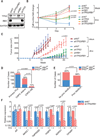SOX2 promotes lineage plasticity and antiandrogen resistance in TP53- and RB1-deficient prostate cancer
- PMID: 28059768
- PMCID: PMC5247742
- DOI: 10.1126/science.aah4307
SOX2 promotes lineage plasticity and antiandrogen resistance in TP53- and RB1-deficient prostate cancer
Abstract
Some cancers evade targeted therapies through a mechanism known as lineage plasticity, whereby tumor cells acquire phenotypic characteristics of a cell lineage whose survival no longer depends on the drug target. We use in vitro and in vivo human prostate cancer models to show that these tumors can develop resistance to the antiandrogen drug enzalutamide by a phenotypic shift from androgen receptor (AR)-dependent luminal epithelial cells to AR-independent basal-like cells. This lineage plasticity is enabled by the loss of TP53 and RB1 function, is mediated by increased expression of the reprogramming transcription factor SOX2, and can be reversed by restoring TP53 and RB1 function or by inhibiting SOX2 expression. Thus, mutations in tumor suppressor genes can create a state of increased cellular plasticity that, when challenged with antiandrogen therapy, promotes resistance through lineage switching.
Copyright © 2017, American Association for the Advancement of Science.
Figures




Comment in
-
Reprogramming to resist.Science. 2017 Jan 6;355(6320):29-30. doi: 10.1126/science.aam5355. Science. 2017. PMID: 28059730 No abstract available.
-
Re: SOX2 Promotes Lineage Plasticity and Antiandrogen Resistance in TP53- and RB1-Deficient Prostate Cancer.J Urol. 2017 Aug;198(2):259. doi: 10.1016/j.juro.2017.05.011. Epub 2017 May 11. J Urol. 2017. PMID: 29370655 No abstract available.
References
Publication types
MeSH terms
Substances
Grants and funding
- P30 CA016056/CA/NCI NIH HHS/United States
- R01 CA193837/CA/NCI NIH HHS/United States
- P50 CA092629/CA/NCI NIH HHS/United States
- R01 CA207757/CA/NCI NIH HHS/United States
- P30 CA008748/CA/NCI NIH HHS/United States
- R01 CA155169/CA/NCI NIH HHS/United States
- R01 CA116337/CA/NCI NIH HHS/United States
- R21 CA179907/CA/NCI NIH HHS/United States
- T32 CA009072/CA/NCI NIH HHS/United States
- T32 CA160001/CA/NCI NIH HHS/United States
- U54 OD020355/OD/NIH HHS/United States
- P01 CA013106/CA/NCI NIH HHS/United States
- R01 DC019387/DC/NIDCD NIH HHS/United States
LinkOut - more resources
Full Text Sources
Other Literature Sources
Medical
Molecular Biology Databases
Research Materials
Miscellaneous

